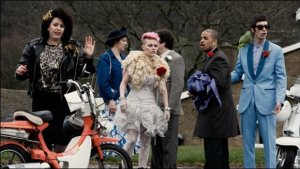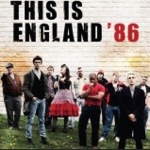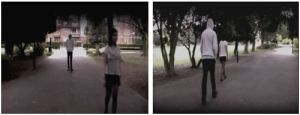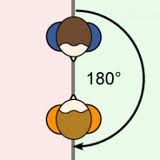I will be analysing the camerawork, sound design, mise-en-scene and editing of the montage scene before the climax of the episode. Initially it sets us up for the end of what is about to come and the overall feel of this particular montage with dialogue and diegetic sound in is bittersweet. Because it is contrasting emotions of different characters. Each character is shown for an equal amount of time showing their joint importance in the scene. For some characters in the scene for example Lol and Trev shows simply a moment in time; however, for others like Woody and Milky there is still an element of exposition.
The camerawork during this scene begins with a close-up shot on Lol and Trev promoting a sense of intimacy and the 180 degree rule again shows every emotion they are feeling. This is because the audience know what Trev is going to tell Lol, about her tragedy. There is a wide shot used on the garages and houses to show to the audience where this is set, in a deprived urban city area perhaps to show a sense of lifestyle of these characters to the audience. When the camera focuses on Shaun the rule of thirds is applied, making it more intimate with the audience and it is shot in darkness similar to the way Lol and Trev’s scene is filmed to mirror the emotions in both scenes and connect the two together. The camera then switches to a mid-shot of Mike(the dad) and Kell in the bedroom. The audience worry what he will do showing her vulnerability because they are aware, unlike Kell, what he has done to Trev. In comparison though, the camera tilts when Milky is talking to Trudy out the window, it looks down on him as if from her point of view, the placement of the light-hearted scenes such as this and the scenes showing tragedy creates a balance for the audience. Finally, Combo in the shower s filmed from above and it is a close-up of him for the first time in the movie showing his vulnerability.

The editing in this scene begins when Trev explains to Lol about the tragedy and it is in slow motion, this intensifies the emotion and hurt in the scene. However, faster paced action is used on Woody and Milky because they are still unaware of what is happening around them, they are still going about their normal lives. There is a lot of cross-cutting between each scenes, showing they are happening simultaneously and there is a relationship between them. Fast cuts are made between Woody and Milky, again, to show what they are doing at the same time everything else is happening. There is then the scene where the dad is sat on the bed with Kell, to Trev hugging Lol which includes another story into the mix so the audience is now aware of someone else’s life.
At the beginning of the scene when the music begins it makes the audience automatically feel sad. It is a composed, non-diegetic piece played throughout the duration of the scene. There is a sound bridge between Trev’s scene and Woody’s scene again merging the two together and showing they are happening simultaneously. The music’s dynamics and pitch quitenes when there is dialogue such as when Woody and Milky are speaking because this scene isn’t as tragic compared to the others. The music tends to reflect the mood of the characters mirroring thei emotions, it is quite a dark and depressing peice of music showing making the audience empathise with how they are feeling.
The mise-en-scene in this scene, to begin with is the dark, depressive weather used to film in. The happiness and optimism of woody is juxtaposed with the grey, oppressive weather. The weather may be overshadowing the tragic event that has taken place hanging over everyone. Furthermore, the main props in this scene are the mods that Woody and Milky used, this is to perhaps create a nostalgic feel to the scene back to the 80s, again making it more believable for the audience. Moreover, when it is the scene between the father and Kell, it is clear that they are in her room which is a child’s room, to show her innocence and vulnerability.





